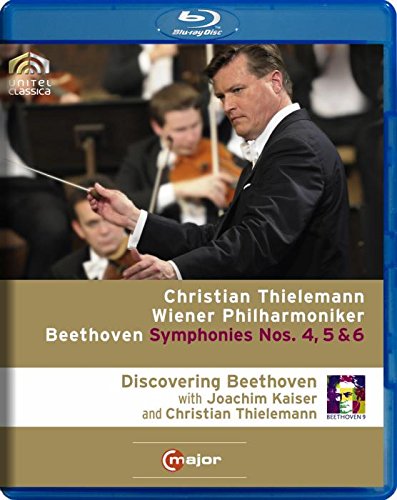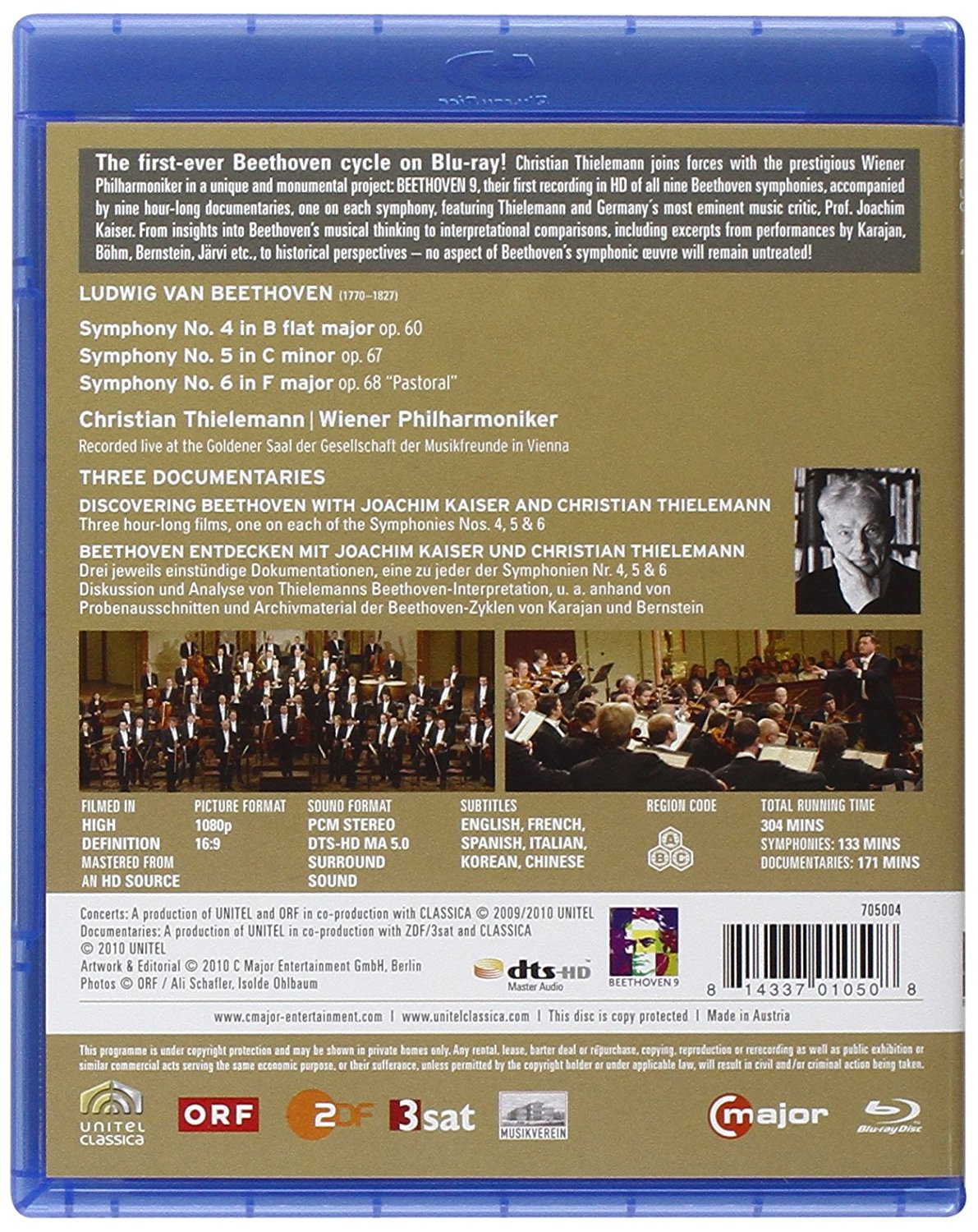

Beethoven Symphonies 4-6 concert. Christian Thielemann conducts the Wiener Philharmoniker in Symphonies 4-6 for a total of 133 minutes of music. Agnes Méth was video director for Symphony 4 recorded in 2009. Karina Fibich was video director for Symphony 5 and Symphony 6, both recorded in 2010.
Also comes with three Discovering Beethoven documentary films, one for each symphony, with conversations between Thielemann and music critic Joachim Kaiser. All the documentary films were made by Christoph Engel. Each documentary lasts for almost an hour for a total of 171 minutes.
The total running time for the music and documentaries is 304 minutes on one disc. Released 2010, disc has 5.0 dts-HD Master Audio for the music. Documentaries are in high-definition video with PCM stereo sound. Blended grade for 3 symphonies: C
This is the second title in the C Major three-title set with nine Beethoven symphonies. See the mini-review for the Beethoven Symphonies 1-3 concert for general information.
It's fun to see how the orchestra changes with each symphony (something you would never think about listening to CDs). For example, the Wiener Philharmoniker is still a pretty chauvinistic outfit. There is not a single woman on the stage for the Symphony 4 concert. But Symphony 5 requires larger forces, and 4 women get to join the men. Symphony 5 is the weightiest yet in the series: a contra-bassoon, a piccolo, a three trombones appear for the first time. And the bones are marshaled as scored: a tomboy sister alto, a big brother tenor, and a bigger papa bass.
We should also mention that the documentaries have clips of performances by other famous conductors of the past. For example, Thielemann and Kaiser discuss a short passage from Symphony 6 marked "più mosso" or "move a bit faster." Thielemann gives his opinion how to play it, and then you see recordings of the same passage by five other great conductors. Now lets focus on each of the symphonies on this disc.
Beethoven Symphony No. 4
This was shot by Agnes Méth in 2009 at the same time she recorded her Symphony No. 3 in this series. We said in that review that Méth was presenting a DVD in HDVD clothing, and we gave it a "C" grade. We urge you to read that review now.
We just finished watching subject Symphony No. 4 and feel that all the comments we made earlier generally apply also to it. We do note that the pace in No. 4 is somewhat less feverish than it was in No. 3, no doubt due to the more lyrical nature of No. 4. We usually criticize the TV directors for paying too much attention to the conductors. But Méth's depiction of Thielemann leading the Adagio of No. 4 would be an exception — Thielemann looks as if he is begging for his life, and the musicians show mercy.
Méth does in No. 4 give us quite a few whole-orchestra shots and a couple of nice part-orchestra views. We wonder if Méth ever worked as a striptease artist. She knows how to do it. When you notice the men are drowning in their beers, you show it all — but before they can look up and focus their bleary eyes on you, the feathers are already back in place. And so it is with Méth's long-range shots: before you can think "wow," the shot is over and it's back to an image of the bell of a trumpet. We don't want to be too harsh on Méth. The exaltation of promise over performance is every woman's best strategy in dealing with the horrors of men. But the fact remains she is not recording an exotic dancer in this video — no, we are watching one of the world's best symphony orchestras, so why not let us see them fully in all their glory? Again, Méth is not to blame; she was ordered by a suit to make a DVD. And now we tell the suit: it's no sin to make a DVD, but please don't foist it off as an HDVD.
In parting with Méth, we grant there is one cut at the end of No. 4 that is worthy of an HDVD. See 38:53 to 38:07. This starts with a 60% part-orchestra view followed by a slow zoom out to a beautiful 100% view that is then held for another 3 seconds (total 14 seconds). At 28 seconds, this would be twice as good, but it does get over the threshold of a nice HDVD shot. Grade: C
Beethoven Symphony No. 5
This was shot in 2010 by TV Director Karina Fibich. By 2010, the state-of-the-art for PQ had advanced pretty far, and the PQ here will probably not be improved on much until we get 4k resolution. The SQ is probably better also that the previous titles in this series. Too bad, so sad — poor video content drags down everything as this record has a virulent case of DVDitis.
All the horrible symptoms are there in the 388 video views we count: the high fever of a change of video view every 5.4 seconds (on average), 94 conductor shots (24% of the show) including 37 low-blood-pressure shots made over the backs of the musicians, and 42 morbid instrument-only views. The patient can't keep his balance due to excessive panning and zooming around that makes his frame shutter. His body has been wasted by a diet of junk food consisting of short videos of solo players or small parts of the orchestra. None of his most important organs (the 1st violins, 2 violins, and the violas) appear to have ever been exercised. Nine attempts to do a whole-body scan of the patient all failed because the hospital camera was not located in a position where it could accurately see the patient. Even a candy-striper on her first day could tell that this poor soul will not survive even if the clinic spends his last dime trying to keep him alive. (If you are having trouble following this, please excuse us for trying to be funny. Read our grading standards for a symphony HDVD and everything should then be clear.) Grade: C
Beethoven Symphony No. 6
This Symphony No. 6 is such a beautiful performance sonic wise! The PQ remains high. Sadly, the video content is consistent with way Fibich recorded her No. 5. We imagine it makes for an "A" quality DVD. We imagine the HDVD is "better" than the DVD because of the improvement in resolution. But it's still a mediocre HDVD. It doesn't follow Huang's law that a good HDVD should "use the flexible power of the the high-def camera to get a pleasant (not hyperactive) mixture of shots of the whole orchestra, groups of sections, large sections, small sections, groups of sections and individuals, and solo players — depending on what forces the composer commits at various places in the score." Grade: C
OR
